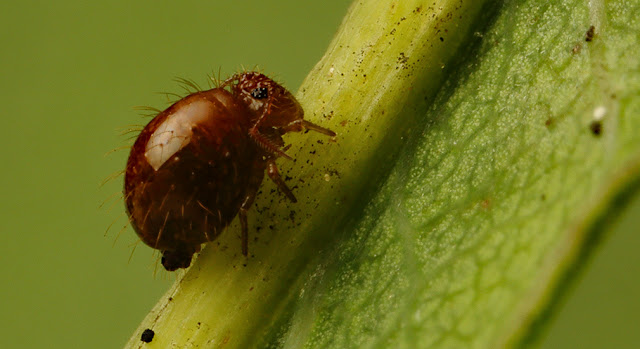3 Min read
Of course I could immediately be shooting myself in the foot here, after all, this is going out over the web, and blogs can be notoriously lacking in factual content themselves. However, like a demented farmer, desperate to beat the failing light and get home for his supper, I shall plough on regardless.
Take a look at a few photos I came across on the internet when I Googled 'Green Lacewing Larvae'
There were many more such examples, even videos. My problem is that most of these images do not depict a Green Lacewing Larva. Proof positive that we need to be very vigilant when using this 'ere interweb thingy. How can I be sure? Because this is what a larva of the Green Lacewing looks like...
A totally different insect. These have the nickname of Trash Bugs. That 'trash' on its back is a mix of plant debris and the remains of prey it has consumed and is using as camouflage and to dissuade any predator from attacking.
It's a tad more complicated than that though, as you might expect. Some Green Lacewing larvae may not cover themselves in this way; but thankfully, there are other differences. Brown Lacewing larvae tend to be larger, have a slightly different body shape and can be more colourful. They also have shorter, less curved mandibles. Here's a couple of photographs of one I found in my garden...
This one is attacking a ladybird lava, possibly a 16-spot?
Quite odd looking aren't they, almost crocodilian (is that even a word?) In the words of Randy Bachman though, 'You ain't seen nothing yet'. How about gettin' yer peepers around this next critter...
It's a....Fly!
Yes, most un-fly-like isn't it.
But that's what it is. Belonging to the Mecoptera order, and Panorpidae (Common Scorpionfly) family. These flies are called Scorpion Flies after, and here comes another stranger than strange fact: 'the males having enlarged genitals that look similar to the stingers of Scorpions. Well, we all have our cross to bear eh? My photo is of a female; females have genitals that look similar to Sting! (There's a joke there, but it's probably too risque to elaborate).
Instead, why don't we develop this odd/strange/weird fetish a tad further? As a PayPal employee said to me when I was struggling to get her to understand the problem I was having with their attitude..."Let's take ownership of this".
If you have been a regular reader of these updates over the past 8 years or so, you will have seen many oddities, but I can guarantee, yes...GUARANTEE, that you will have not seen what follows in this video.
This is stranger than a strange man who is a stranger in a strange town, walking around in a daze listening to 'Strangely, strange but oddly normal, by Dr. Strangely Strange' on his iPod! It's even weirder than Weird Al Yankovic...
Apologies for the quality of this video; it's only a (cropped) phone vid.
This is the detached leg of a Harvestman!
Shall I explain? 'We think you should JJ' - OK then, I will. When threatened by predators, Harvestmen play dead. If
pursued, they will detach a leg (or legs) to escape. The detached legs
continue to move after they have been separated from the body of the Harvestman
and serve to distract predators.
This twitching is due to the pacemakers, located at the end of the first long segment of their legs. The
pacemaker sends a pulse of signals along the nerves of the leg that causes the
muscles to repeatedly expand and contract even after the leg is detached from
the body.
While
some Harvestman's legs twitch for a minute, others have been recorded to twitch
up to an hour. If a Harvestman should lose ALL of its legs, it will just bum around!
Hmmm...too many. Time for a few pictures I think...
 |
| Allacma fusca - A Springtail |
 |
| Bertkauia lucifuga - A Barkfly |
What do these two photographs have in common? Well, firstly I was pleased with both finds. But what intrigued me was that until I got the macro lens on them, I thought these were the same species of critter. Neither one was more than a few millimetres in length and so I suppose it's excusable.
However, the first is a springtail (Collembola) and one that I have only ever found on fence-posts. This one was a couple of metres up an oak tree.
The second is a Barkfly, and a really interesting find as it seems to be quite scarce. Possibly under-recorded, but no records in my area at all.
Next up - Little and Large...
No, not that Little and Large! These...
 |
| Red-legged Shieldbug |
A large (Red-legged) Shieldbug. And a little...
 |
| Coreus marginatus - A Dock Bug nymph |
...Dock Bug nymph. I know this looks quite large here, but it was less than 5mm in reality. I have seen these at various stages previously, but never this tiny. I think this could be a first instar; directly out of the egg.
Time for one last weirdo photo, before this weirdo gets back in his box until the next update...

This is a photograph of a Peacock butterfly pupa, bursting out of the back of a caterpillar. I once filmed the whole process with a Comma butterfly. Here is a LINK to that video from 2011...
*Apologies to anyone who has had problems with getting the email version of this update. It seems Blogger has sent out some incomplete notifications.














No comments:
Post a Comment